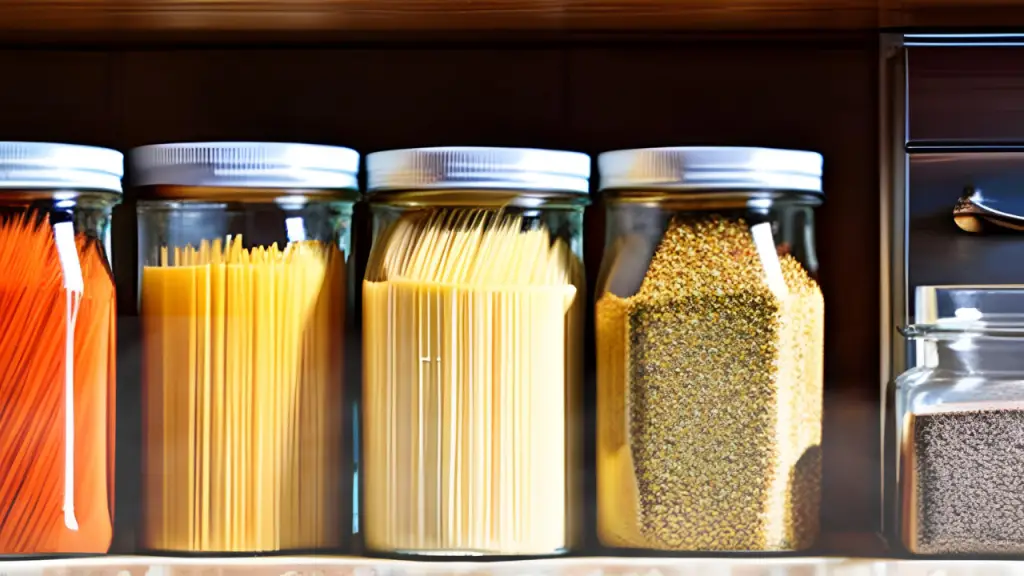
In a world of diverse culinary delights, pasta has secured a special place on the plates of people across the globe. With its versatile nature and countless variations, it’s no wonder that pasta enthusiasts often find themselves with a surplus of different pasta shapes. Storing them in glass jars is a smart choice to maintain freshness and organize your pasta collection efficiently. This article will guide you through how to organize pasta in glass jars, providing practical tips and creative ideas to ensure your kitchen remains well-ordered and visually appealing.
To organize pasta in glass jars for optimal kitchen storage, start by selecting airtight glass jars that can accommodate the quantity of pasta you have. Sort your pasta varieties and transfer them into individual glass jars, ensuring to label them for easy identification. Store the jars in a cool, dry place away from direct sunlight to maintain the quality and freshness of the pasta.
Understanding the Importance of Organizing Pasta
Organizing your pasta in glass jars preserves its freshness and simplifies your kitchen routine. You can easily find the desired pasta shape for a specific recipe in neatly arranged jars without rummaging through cluttered pantry shelves. Additionally, it enhances the visual appeal of your kitchen, creating a sense of order and sophistication.
Selecting the Ideal Glass Jars for Pasta Storage
When choosing glass jars for pasta storage, it’s essential to consider their size, sealability, and aesthetic appeal. Opt for jars with airtight lids to prevent moisture and air from compromising the pasta’s quality: Mason jars, cylindrical jars, or square-shaped jars with clamp lids. Ensure the jars are transparent to showcase different pasta shapes’ vibrant colors and textures.
Preparing Pasta for Storage
Before transferring pasta to glass jars, ensuring they are clean and dry is crucial. Any moisture in the jars can lead to the formation of mold or spoilage. Empty the pasta into a sieve or colander, and give it a gentle shake to remove any loose debris. Let the pasta air-dry on a clean kitchen towel for a few minutes until it reaches a moisture-free state.
Sorting Pasta by Types and Sizes
Sorting pasta by types and sizes is highly recommended to maximize organization and ease of use. Separate long pasta like spaghetti, linguine, and fettuccine from short pasta such as penne, fusilli, and farfalle. Classify them according to their composition, such as regular, whole wheat, or gluten-free. This arrangement will streamline your cooking process and ensure you can quickly locate the necessary pasta.
Utilizing Labeling Techniques for Easy Identification
Labeling your glass jars is a practical way to identify different pasta shapes and types without opening each one. Create labels using adhesive paper or cardstock and affix them to the front of the jars. Write the name of the pasta shape clearly, and if desired, include additional details such as the cooking time or any specific recipe suggestions.
Displaying Pasta Jars for Aesthetic Appeal
While functionality is vital, organizing pasta in glass jars can also be an opportunity to enhance the visual appeal of your kitchen. Arrange the jars visually pleasingly, considering factors like size, color, and texture. For instance, you can group jars with similar pasta shapes or create a gradient effect with different-colored pasta. Be creative and use your pasta collection as a decorative element in your kitchen space.
Practical Tips for Efficient Pasta Organization
- Store pasta jars away from direct sunlight and heat sources to maintain optimal freshness.
- Consider using stackable jars or utilizing vertical space with wall-mounted racks or shelves.
- Regularly check the pasta jars for any signs of spoilage or infestation and discard any compromised pasta immediately.
- Keep a small inventory log or digital note of the pasta types and quantities to ensure you restock when necessary.
- Explore innovative storage solutions like magnetic strips or pegboards to hang smaller glass jars for spices or condiments.
Conclusion
Organizing pasta in glass jars provides an efficient and visually appealing solution for maintaining the freshness and accessibility of your pasta collection. Following the steps outlined in this guide, you can transform your pantry or kitchen into a well-organized culinary haven. Remember to select suitable glass jars, sort and label the pasta appropriately, and get creative with their display. With a harmonious balance of functionality and aesthetics, your organized pasta jars will become a delightful focal point in your kitchen.
FAQ
Can I store pasta in plastic containers instead of glass jars?
While glass jars are preferred for pasta storage due to their airtight properties and aesthetic appeal, plastic containers can also be used as long as they have secure lids. Ensure the containers are food-safe and free from any lingering odors that could affect the pasta’s taste.
Is it necessary to store pasta in airtight containers?
Yes, storing pasta in airtight containers, such as glass jars, helps maintain its freshness by preventing exposure to moisture, air, and potential contaminants. Airtight containers also prevent the pasta from absorbing unwanted odors from other pantry items.
Should I refrigerate the pasta stored in glass jars?
Refrigerating pasta stored in glass jars is only necessary if already been cooked. Uncooked pasta can be stored at room temperature in a cool, dry place away from direct sunlight.
How long can pasta be stored in glass jars?
Uncooked pasta can retain its quality for up to 1-2 years when stored in glass jars with proper seals. However, for the best flavor and texture, consuming the pasta within 6-12 months is recommended.
Can I reuse glass jars from other food products for storing pasta?
Reusing glass jars is an eco-friendly option for pasta storage. Ensure the jars are thoroughly cleaned, free from any residue or strong odors, and have airtight lids. It’s advisable to repurpose jars of similar size to maintain consistency in your organized pasta storage system.
